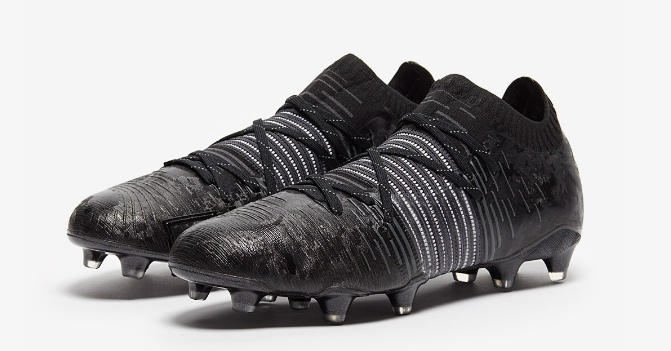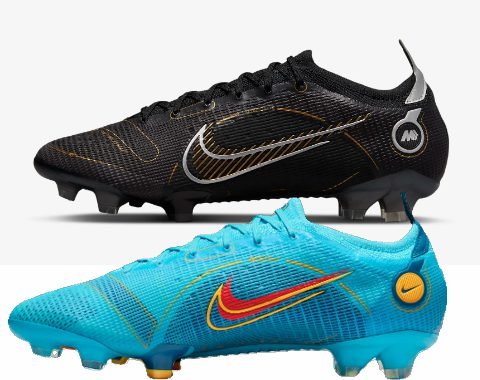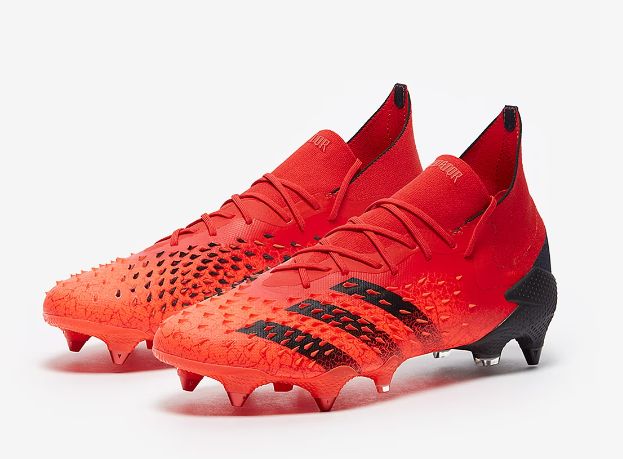Soccer Boots History: Evolution, Technologies, and Materials
Football boots, also known as cleats or soccer shoes in North America, are an essential piece of equipment worn by players when playing association football. From humble beginnings, football boots have come a long way over the years, subject to much research, development, sponsorship, and marketing, and are now at the heart of a global multi-national industry. This article will explore the history of soccer boots, detailing how they have evolved over the years to become the specialized footwear that they are today. Let’s dive in.
1800s - The early years
During the 19th century, football became extremely popular in Great Britain. The first players wore their heavy and hard work boots to play. These boots were the first ever boots with a steel toe cap at the front, long laces, and high tops. To improve grip and stability, metal studs or tacks were added to the bottom of the boots. In the later part of the 19th century, the first-ever football-specific boot was designed, made of thick and heavy leather which ran right up to the ankle for increased protection. The first boot weighed 500 grams (18 oz) and would double in weight when it was wet.
1900s to 1940s - Staying Basic
During this period, the style of football boots remained very basic. Despite many famous football boot producers, such as Gola, Hummel, and Valsport becoming ever more popular during the inter-war years, football boots remained very simple in design.
1940s to 1960s - Dramatic Changes
After the Second World War, the design of the football boot changed dramatically. The South Americans were the first to wear lighter and more flexible boots, which later came to the attention of the world. This design focused on increasing good control and better kicking power rather than a more protective boot. In 1954, Adi Dassler introduced screw-in studs which gave the German team a tangible advantage during a rain-lashed World Cup that year. It is disputed by his older brother, Rudolf Dassler, founder of Puma, that Adi Dassler was the first to come up with screw-in studs.
In the 1960s, many football boots were designed with a lower cut and were designed to be lighter and more flexible. These enabled the best players in Europe and South America to move faster and change direction quicker. Mitre, Joma, and Asics joined the fray, and Adidas became the top manufacturer during this decade, with 75% of players at the 1966 FIFA World Cup wearing Adidas.
1970s to 1990s - Advances and Changes
The 1970s saw many advances and changes in the football boot design. These included lighter boots and a variety of colors. Boot sponsorship also became more widespread. Adidas was the market leader in this period, releasing new technologies such as padding to provide heel protection. At the end of the decade, in 1979, it cemented its status by releasing what has gone on to become the best-selling boot of all time, the Copa Mundial. During this time period, some of the most common types of natural leather came into production: kangaroo leather, calfskin, and full-grain/cow leather. Diadora entered the market in this decade.
The 1980s saw further advancements in the technological development of football boots from the 1970s. Umbro, Lotto, and Kelme all joined the market in this decade, and a new trend emerged with the use of synthetic materials in the construction of football boots.
1990s to 2000s - New Technologies and Innovations
In the 1990s new types of sole were introduced to increase the balance of the player, and the Adidas Predator, designed by Australian Craig Johnston in the late 1980s, was released in 1994 and enjoyed instant success. Mizuno, Reebok, Uhlsport, and Nike all began making football boots in this decade. Nike's first boot, the Nike Mercurial Vapor, immediately made an impact upon its release in 1998, and after Ronaldo wore them at the 1998 FIFA World Cup, they quickly became a fan favorite.
2000s: In the first decade of the 21st century, laser technology was introduced to produce the first fully customized football boot in 2006. The first laceless boot, the Lotto Zhero Gravity, was also released in 2006. Laceless boots later became very popular in the late 2010s.
The 2010s - Technology and Customization Take Center Stage
Enter the modern era of the game that sees the tempo of matches becoming faster and players more technically inclined, manufacturers introduced new advances in technology, including lighter footwear made from alternative materials. Boot customization also became more prominent with the rise of the internet and social media.
Laceless boots continued to be popular in the 2010s, with Adidas releasing the Ace PureControl in 2016. This boot featured no laces and was designed to provide maximum comfort and performance.
The mid-2010s also saw the introduction of a new type of sole known as "blades." These soles have specially designed boots with moulded soles facing in multiple directions, theoretically to maximize grip and minimize ankle injury. However, "bladed" football boots have faced criticism from some UK sporting bodies for causing potentially serious injuries to players.
The Rise of Synthetic Materials
In addition to customization, the development of new materials also played a major role in the evolution of soccer boots. While leather had long been the primary material used for soccer boots, synthetic materials began to gain popularity in the 1990s and 2000s. These materials offered several benefits, including increased durability and reduced weight.
One of the most popular synthetic materials used in soccer boots is polyurethane (PU). PU is a lightweight, flexible material that is used to create the uppers of many modern soccer boots. Other synthetic materials used in soccer boots include nylon, mesh, and various types of plastics.
While synthetic materials have become increasingly popular in recent years, some players still prefer the feel and performance of leather boots. Kangaroo leather, in particular, is a favorite among many professional players due to its softness, durability, and ability to mold to the foot over time.
Different Styles for Different Sports
Depending on the type of surface, kind of sport, and even the wearer's position or role in the game, different styles of boots and particularly stud configurations are available. For hard pitches, amateur participants may wear a sneaker shoe or a plastic-stud boot (known as a "moulded sole" or "firm ground" boot); in most sports and positions, this is adequate, although on a well-grassed or sodden field, screw-in studs are recommended for more grip; these may be metal, rubber, or plastic and are called "soft ground" boots. When playing on this kind of pitch, some players favor using a boot with screw-in studs in their non-dominant (supporting) foot to provide grip, and a boot with short rubber or plastic studs in the dominant (kicking/passing) foot to provide accuracy. However, most players opt for a consistent configuration on both boots.
For indoor football, indoor boots are used. These come with rubber soles, meant to maximize grip on the floor. Some are built on the design of firm-ground football boots, and some are specifically designed for the indoor game. For football on turf or artificial grass, some players wear regular firm ground football boots. But wearing regular football boots on turf greatly reduces the life of the boot, so companies such as Nike have developed football boots for artificial grass (AG), which have smaller circular studs.
Football Markets and Brands
Originally, football boots were available only in black. Still, in recent years, they have become available in various colors such as blue, green, red, white, yellow, silver, gold, and even pink. The market for football boots has become a highly competitive one, with big-name companies such as Nike, Adidas, Puma, and others vying for record sales.
Nike's flagship shoes are the Phantom VNM, Phantom VSN, Tiempos, and The Nike Mercurial Vapor worn by Cristiano Ronaldo and others. Adidas is responsible for the Predator range worn by David Beckham, Gary Neville, and Steven Gerrard, as well as the long-surviving Copa Mundial. Another German firm, Puma, has also made a significant impact in the industry by signing big names such as World Cup winners Antoine Griezmann, Marco Reus, and Gianluigi Buffon, David Silva, Cesc Fàbregas, Romelu Lukaku, Mario Balotelli, and Champions League winner Luis Suárez.
In addition to the technological advancements made in football boots, there have been significant changes in their appearance and design over the years. Originally, football boots were only available in black, but they have become available in a variety of colours, including blue, green, red, white, yellow, silver, gold, and even pink.
In recent times, Nike and Adidas have been the most successful companies, and their products enjoy great popularity among professional soccer players. Among Nike's endorsers are two-time FIFA World Player of the Year Ronaldinho, aforementioned duo Wayne Rooney and Cristiano Ronaldo, Brazilian striker Ronaldo, Wesley Sneijder, Zlatan Ibrahimović, and other popular players. Adidas, which has been providing soccer boots with screw-in studs to the Germany national soccer team since the 1954 FIFA World Cup, has made its impact on the modern market by signing big-name players as endorsers: players such as David Beckham, former France captain Zinedine Zidane, Frank Lampard, six-time world player of the year Lionel Messi, David Villa, and other world-class players.
Customization
Many players around the world use personalization to improve the look of their boots and make them easily identifiable in the club dressing room. It is now very common to have football boots fully personalized with either a name, initials, number, or club logo. Professional players such as Lionel Messi, Cristiano Ronaldo, and Neymar have all personalized their boots in some way, either by including their number, the names of their children, or just a flag.
The Bottom Line
Soccer boots have come a long way since their humble beginnings in the 19th century. From simple and heavy leather boots to today's highly advanced and customizable models, soccer boots have undergone much research, development, sponsorship, and marketing at the heart of a multinational global industry. Today, soccer boots have become more than just a functional piece of equipment; they have become an extension of a player's personality and style on the pitch. With a continued focus on innovation and technology, it is certain that the future of soccer boots will be bright and exciting, bringing new levels of performance and style to the world's most popular sport.

















